Effects of selenium source and level on growth performance,antioxidative ability and meat quality of broilers
WANG Chuan-long,XlNG Guan-zhong ,WANG Li-sai,Ll Su-fen,ZHANG Li-yangLU LinLUO Xu-gang,LlAO Xiu-dong
1 Mineral Nutrition Research Division,Institute of Animal Sciences,Chinese Academy of Agricultural Sciences,Beijing 100193,P.R.China
2 Poultry Mineral Nutrition Laboratory,College of Animal Science and Technology,Yangzhou University,Yangzhou 225000,P.R.China
3 Department of Animal Science,Hebei Normal University of Science and Technology,Qinhuangdao 066004,P.R.China
Abstract This experiment was conducted to investigate the effects of selenium (Se) source and level on growth performance,carcass traits,antioxidative ability and meat quality of broilers. A total of 320 one-d-old Arbor Acres commercial broilers were randomly assigned to 1 of 5 treatments with 8 replicates in a completely randomized design involving a 2×2 factorial arrangement of treatments plus one Se-unsupplemented basal diet control for 42 d. The two Se sources were sodium selenite and Se yeast,and the two supplemental Se levels were 0.20 and 0.40 mg Se kg-1. The results showed that broilers fed the Se-supplemented diets had higher (P<0.05) average daily gain and average daily feed intake from 22 to 42 d of age,eviscerated yield and abdominal fat percentages,Se concentrations and glutathione peroxidase (GSH-Px) activities in breast and thigh muscles on d 42,and lower (P<0.05) feed/gain from 1 to 21 and 22 to 42 d of age,mortality from 22 to 42 d of age and malondialdehyde (MDA) concentration in thigh muscle on d 42 than those fed the control diet. Broilers fed the diets supplemented with Se yeast had higher (P<0.05) pH value and lower (P<0.05) shear force in thigh muscle than those fed the diets supplemented with sodium selenite. Additionally,broilers fed the diets supplemented with 0.40 mg Se kg-1 had lower (P<0.05) shear force in thigh muscle and higher (P<0.05) GSH-Px activities in breast and thigh muscles than those fed the diets supplemented with 0.20 mg Se kg-1. Furthermore,broilers fed the diet supplemented with Se yeast at 0.40 mg Se kg-1 had higher (P<0.05) Se concentrations in breast and thigh muscles than those fed the diet supplemented with Se yeast at 0.20 mg Se kg-1,but no differences (P<0.05) were observed in these indices of broilers fed the diets supplemented with sodium selenite between 0.20 and 0.40 mg Se kg-1. The results from the present study indicated that supplemental Se could increase the growth performance,muscle Se concentration and antioxidative ability of broilers; and the Se from Se yeast was more effective than the Se from sodium selenite in improving meat quality of broilers.
Keywords:selenium source,growth performance,meat quality,antioxidative ability,broiler
1.lntroduction
Selenium (Se) is an essential trace element that has a large number of biological functions for human and animals(Rayman 2000; Yuanet al.2011; Edens and Sefton 2016;Zhanget al.2018). Dietary supplemental Se has been shown to positively affect the growth performance,antioxidation and immune function of broilers (Swainet al.2000; Wang and Xu 2008; Wanget al.2011a; Liaoet al.2012; Skřivanet al.2012).Se is a critical component of the Se-containing proteins or enzymes such as glutathione peroxidase (GSH-Px),which plays an important role in the antioxidative protective system(Hoffmann and Berry 2008; Caiet al.2012; Leeet al.2014;Daliaet al.2018). The inorganic sodium selenite and organic Se yeast are commonly-used Se sources in the feed industry(Yuanet al.2011; Surai and Fisinin 2014). Consumers are becoming increasingly interested in meat quality in recent years. Wanget al.(2011b) reported that supplementation of 0.15 mg Se kg-1from sodium selenite might improve meat quality and shelf life by reducing drip loss in meat of chicken.Jianget al.(2009) reported that supplementation of 0.225 mg Se kg-1from Se yeast was more effective in improving meat pH and color of broilers than the sodium selenite. However,several studies have also shown that supplemental sodium selenite or Se yeast had no effect on meat quality of broilers(Chenet al.2013,2014). Therefore,the exact effects of dietary Se source and level on meat quality of broilers need to be further studied. Dietary supplementation of Se might improve meat quality possibly due to enhanced antioxidative ability and Se deposition in muscle of broilers (Oliveiraet al.2014). The Se yeast is more available for increasing the GSH-Px activity and Se deposition in muscle of broilers(Ahmadet al.2010). Therefore,it was hypothesized that the Se from Se yeast was more effective than Se from sodium selenite in improving meat quality of broilers. The objective of the present study was to assess the effects of different Se sources and levels on growth performance,carcass traits,antioxidative ability and meat quality of broilers in order to test the above hypothesis.
2.Materials and methods
2.1.Experimental design and treatments
The experiment was a completely randomized design involving a control plus 2×2 factorial arrangement. Two supplemental Se sources were sodium selenite and Se yeast,and two supplemental Se levels were 0.20 and 0.40 mg Se kg-1diet according to our previous study (Liuet al.2020). There was a total of five treatments in this experiment because the two Se sources shared one Seunsupplemented basal diet control.
2.2.Animals
All experimental procedures were approved by the Animal Management Committee (in charge of animal welfare issue)of the Institute of Animal Sciences,Chinese Academy of Agricultural Sciences (IAS-CAAS,Beijing,China) and performed in accordance with the guidelines. Ethical approval on animal survival was given by the animal ethics committee of IAS-CAAS. A total of 320 one-d-old Arbor Acres commercial broilers (male:female=1:1) were assigned randomly to five treatments of eight replicate cages each with eight birds per cage. Broilers were housed in an electrical heated,thermostatically controlled room. Feeding management throughout the experiment followed the Arbor Acres broilers management guidelines.All broilers were allowedad libitumaccess to feed and tap water. Dead chicks were recorded daily. At 21 and 42 d of age,the weight and feed intake of broilers per cage were measured to calculate average daily gain (ADG),average daily feed intake (ADFI) and feed to gain ratios (F/G) as well as mortality from 1 to 21 and 22 to 42 d of age.
2.3.Diets
The basal corn-soybean meal diets for starter and grower broilers as shown in Table 1 were formulated to meet or exceed the NRC (1994) broiler requirements for all nutrients except for Se (the NRC’s Se requirement is 0.15 mg kg-1).The Se sources were added to the basal diets according to the above experimental treatments. The sodium selenite was purchased from Beijing Biochemical Reagent Company(reagent grade,containing Se 44.25%) and diluted with corn starch into premix containing Se 1 026 mg kg-1. The Se yeast was purchased from Angel Yeast Co.,Ltd.,China(containing Se 2 265 mg kg-1). The analyzed dietary Se contents were shown in Table 2.
2.4.Sample collections and preparations
The samples of feed ingredients and diets from all the treatments were taken and submitted for CP,Ca and Seanalyses prior to the initiation of the trial to confirm their contents in diets. At 42 d of age,one male and one female broilers were selected from each replicated cage after a 12-h fast. Then the chicks were killed by cervical dislocation,the thigh and breast muscle were immediately collected and frozen at -20°C for measurements of malondialdehyde(MDA) content and GSH-Px activity. Samples from another two broilers (one male and one female) in each replicate cage were used for determinations of meat quality and carcass traits,respectively.
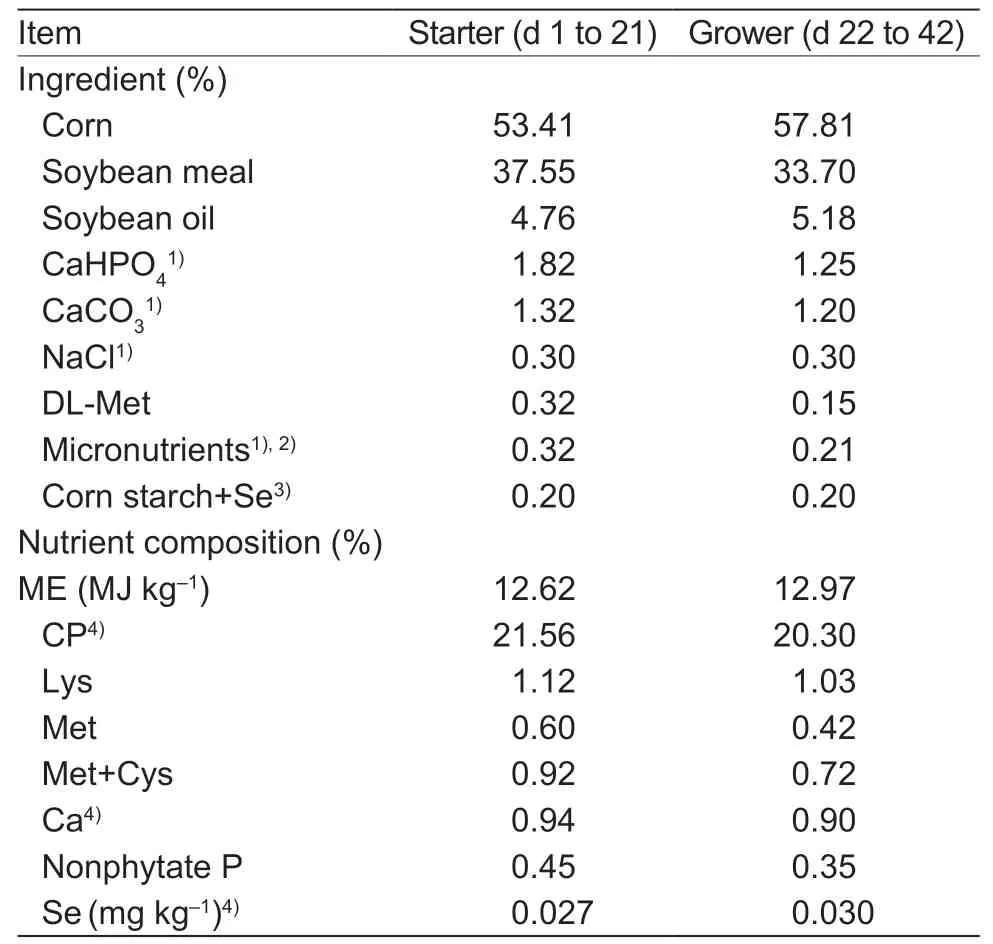
Table 1 Composition of the basal diets for broilers (as-fed basis)
2.5.Carcass traits and meat quality
The broilers were slaughtered and scalded in a hot water bath and the feathers were removed mechanically after bleeding. Then the weight of carcass,abdominal fat,eviscerated yield,breast and leg muscles were weighed to determine the carcass traits of broilers as described by Liuet al.(2011).
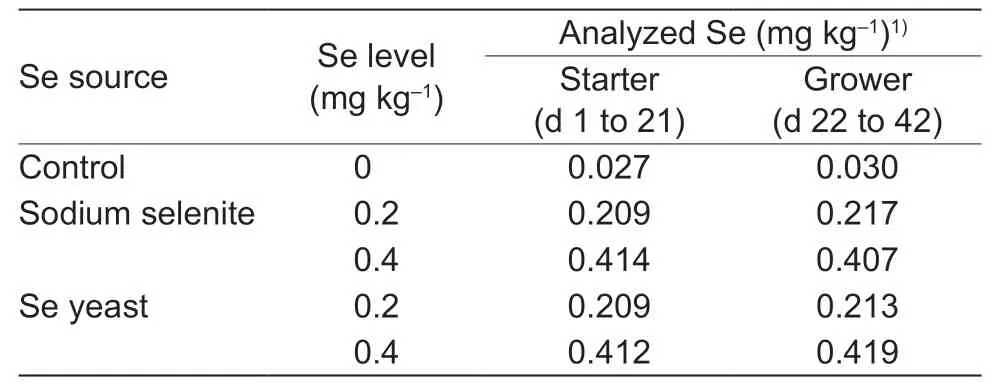
Table 2 Analyzed Se contents in diets for broilers (as-fed basis)
Meat color was measured by a Minolta Reflectance Colorimeter (model WSC-S; Shanghai Precision and Scientific Instrument Co.,Shanghai,China) according to the CIE L*a*b* color system. The pH values of breast and thigh muscles were measured by a Model pH-211 meter(Hanna Instruments Inc.,Padova,Italy). Drip loss was determined as reported by Rémignonet al.(1996). Shear force was determined using a C-LM Muscle Tenderness Instrument (Northeast Agricultural University,Harbin,China)as described by Gwartneyet al.(1992).
2.6.Sample analyses
The CP and Ca contents in feed ingredients and diets were determined using AOAC methods (1990). The fluorescence method was used to determine the Se contents in feed ingredients,diets,breast and thigh muscles (Liaoet al.2012;Zhanget al.2018). The GSH-Px activity and MDA contents in breast and thigh muscles were measured using the GSHPx and MDA assay kits (Nanjing Jiancheng Bioengineering Institute,Nanjing,China).
2.7.Statistical analyses
Statistical analyses were performed using the GLM Program in SAS 9.4 (SAS Institute Inc.,Cary,NC). To test the effect of supplemental Se,data were analyzed using single degree of freedom contrast to compare all Se-supplemented treatments with the control. The data from the growth performance of broilers in all of the Sesupplemented treatments after removal of the control group were analyzed as a 2×2 factorial arrangement,and the statistical model included the addition of Se source,Se level and their interaction. The other data were analyzed as a 2×2×2 factorial arrangement,and the statistical model included the addition of Se source,Se level,gender,and interactions among the three factors. The data of different genders were combined for analyses because there were no interactions (P>0.05) among gender,Se source and Se level. Differences among means were tested by the least significant difference method. Data from mortality of broilers were transformed using arcsin before statistical analysis.The cage was the experimental unit. The significant difference was set atP<0.05.
3.Results
3.1.Growth performance
Broilers fed the Se-supplemented diets had higher (P<0.05)ADG and ADFI from 22 to 42 d of age,and lower (P<0.05)F/G from 1 to 21 and 22 to 42 d of age and mortality from 22 to 42 d of age compared with the control broilers,but there were no differences (P>0.05) in ADG,ADFI,and mortality between the broilers fed the control diet and those fed Se-supplemented diets from 1 to 21 d of age (Table 3).The Se source,Se level and their interaction had no effect(P>0.05) on ADG,ADFI,F/G and mortality during either experimental period.
3.2.Carcass trait
Broilers fed the Se-supplemented diets had higher(P<0.05) percentages of eviscerated yield and abdominal fat compared with the control broilers,but no differences(P>0.05) were observed in the percentages of dressing,breast and thigh muscles between the broilers fed the Sesupplemented diets and those fed the control diet (Table 4).The Se source and the interaction between Se source and Se level affected (P<0.05) percentage of eviscerated yield,but Se source,Se level and their interaction had no effect (P>0.05) on the percentages of dressing,abdominal fat,breast and thigh muscles. No difference (P>0.05)was observed in eviscerated yield percentage of chicks fed the 0.20 mg Se kg-1diets when sodium selenite and Se yeast were compared. However,the broilers fed the sodium selenite diet had higher (P<0.05) eviscerated yield percentage than those fed the Se yeast diet at 0.40 mg Se kg-1.
3.3.Meat quality
No differences (P>0.05) were observed in meat color,pH value,shear force and drip loss of breast and thigh muscles between the broilers fed the Se-supplemented diets and those fed the control diet (Table 5). The Se source affected(P<0.05) pH value and shear force of thigh muscle,the Se level affected (P<0.05) shear force of thigh muscle. But the Se source,Se level and their interaction had no effect(P>0.05) on L*,a* and b* values,pH values,shear force and drip loss of breast and thigh muscles. Compared with the chicks fed the diet supplemented with sodium selenite,chicks fed the diet supplemented with Se yeast had higher (P<0.05) pH value and lower (P<0.05) shear force of thigh muscle. Compared with the chicks fed the diets supplemented with 0.20 mg Se kg-1,chicks fed the diets supplemented with 0.40 mg Se kg-1had lower (P<0.05)shear force of thigh muscle.
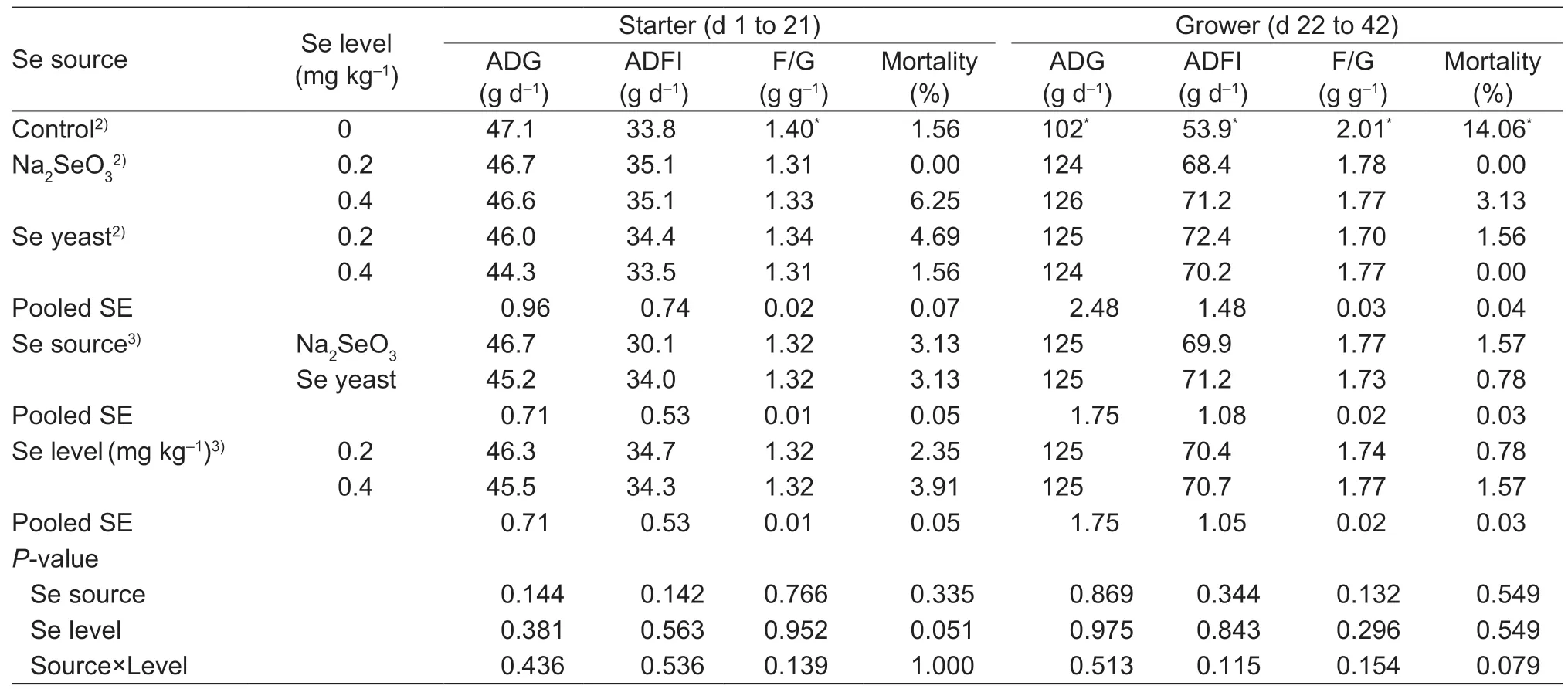
Table 3 Effects of dietary Se source and level on growth performance of broilers1)
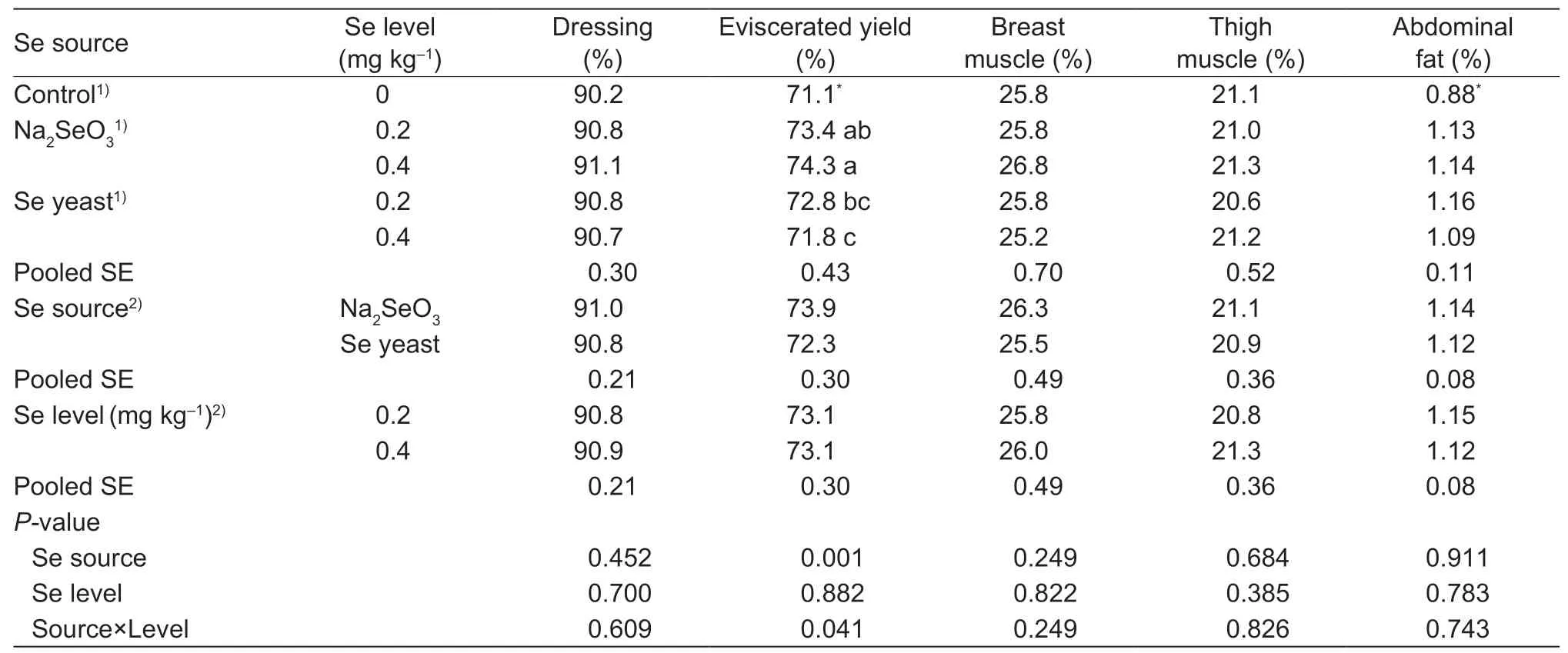
Table 4 Effects of dietary Se source and level on carcass traits of broilers
3.4.Tissue Se content and antioxidation
Broilers fed the Se-supplemented diets had higher(P<0.05) Se contents and GSH-Px activities in breast and thigh muscles,and lower (P<0.05) MDA contents of thigh muscle compared with the control broilers,but there were no differences (P>0.05) in MDA content of breast muscle between the broilers fed the Se-supplemented diets and those fed the control diet (Table 6). The Se source,Se level and their interaction affected (P<0.0001) Se contents in breast and thigh muscles of broilers. The Se level affected(P<0.03) GSH-Px activities in breast and thigh muscles,however,the Se source and the interaction between Se source and Se level did not affect (P>0.05) GSH-Px activities in breast and thigh muscles. The interaction between Se source and Se level affected (P<0.05) MDA contents of thigh muscle,but did not affect (P>0.05) MDA contents of breast muscle. The Se source and Se level did not affect (P>0.05)MDA contents of breast and thigh muscles. The chicks fed the Se yeast diet at 0.40 mg Se kg-1had higher Se contents than those fed the Se yeast diet at 0.20 mg Se kg-1; however,there were no differences (P>0.05) in Se contents between the chicks fed the sodium selenite diet at 0.40 mg Se kg-1and those fed the sodium selenite diet at 0.20 mg Se kg-1.The broilers fed the diets supplemented with 0.40 mg Se kg-1had higher (P<0.05) GSH-Px activities in breast and thigh muscles compared with those fed 0.20 mg Se kg-1diets.The broilers fed the Se yeast diets at 0.20 mg Se kg-1had higher (P<0.05) MDA contents of thigh muscle than those fed the sodium selenite diets at the same level; however,there were no differences (P>0.05) in MDA contents of thigh muscle of chicks fed either the sodium selenite or Se yeast diets at 0.40 mg Se kg-1.
4.Discussion
The hypothesis that the Se from Se yeast was more effective than the Se from sodium selenite in improving meat quality of broilers was partly supported by the results that broilers fed the diets supplemented with Se yeast had higher pH value and lower shear force in thigh muscle than those fed the diets supplemented with sodium selenite. In addition,supplemental Se yeast increased the Se concentrations in breast and thigh muscles of broilers. Therefore,these findings provided scientific experimental bases for improving meat quality of broilers with Se supplementation.
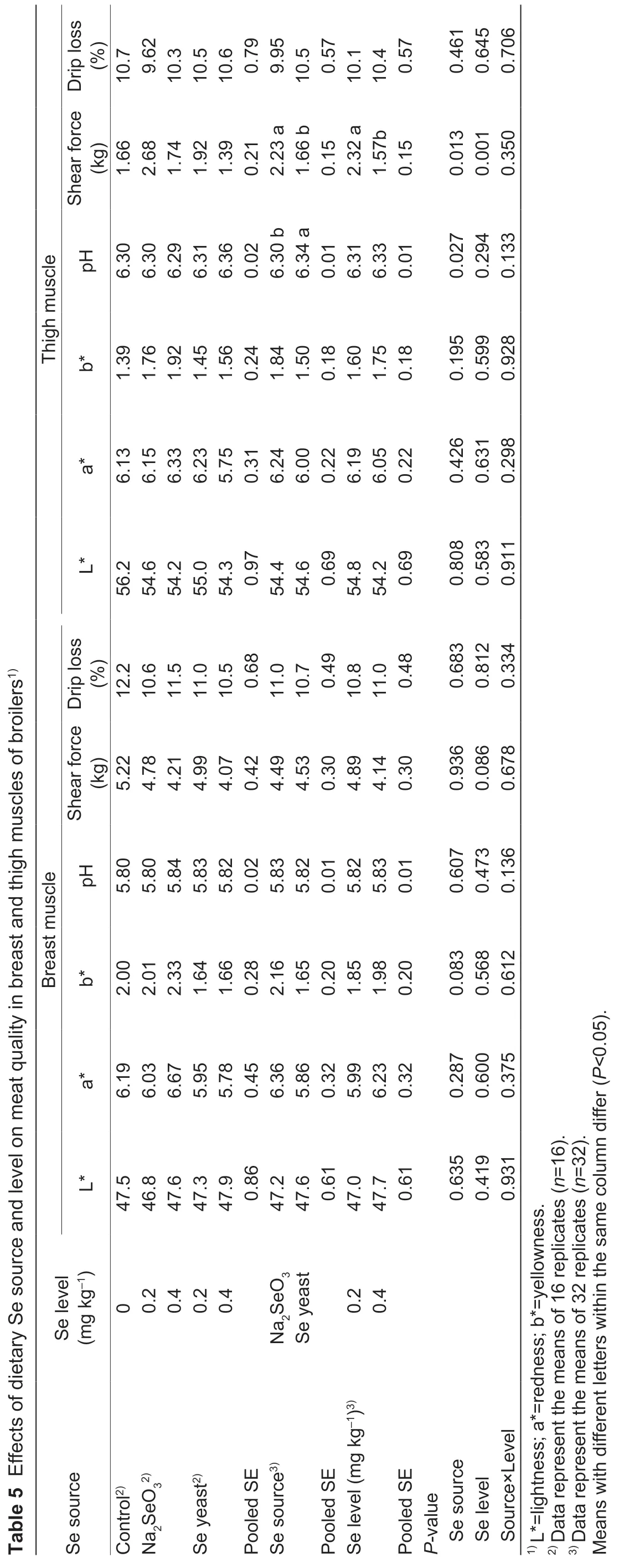
Many studies have demonstrated that the Se could regulate animal growth (Kuchan and Milner 1992; Ozbalet al.2008). Se is an essential trace element with vital functions in animals including its role as an integral component of selenoproteins. It is the cofactor and activator of 5´ deiodinase that is a key enzyme of triiodo thryonine (T3) synthesis,and T3 is the growth control component of animals particularly in poultry by controlling the body’s energy and protein assimilation. Therefore,supplementation of Se could increase growth performance of chickens possibly due to increased protein digestibility and energy utilization (Skřivanet al.2008,2012; Huet al.2012;Chenet al.2014; Salehet al.2014). A study showed that supplementation of 0.30 mg Se kg-1from sodium selenite or Se yeast could improve the growth performance and carcass traits of broilers (Mansoubet al.2010). The results from the present study also indicated that chicks in all Sesupplemented treatments had higher ADG,ADFI,percentages of eviscerate yield and abdominal fat,with lower F/G and mortality than the control group,indicating that dietary supplementation of Se could enhance the growth performance and carcass traits.The lower abdominal fat percentage of broilers might be due to the lower body weight in the control group. However,the Se source,Se level and their interaction had no effect on growth performance and most of carcass traits of broilers except for percentage of eviscerate yield. Other studies also demonstrated that different Se sources or Se levels had no effect on growth performance and carcass traits of broilers (Chenet al.2013,2014; Oliveiraet al.2014; Liet al.2018). Therefore,these above results indicated that supplemental adequate levels of different Se sources had no effects on these indices of broilers.
Meat color,pH value,shear force,drip loss and antioxidation were important indicators for reflecting the meat quality (Chenet al.2013). Some studies have shown that the Se could enhance oxidation resistance,effectively prevent the myoglobin or oxymyoglobin being oxidized to metmyoglobin,deepen the muscle chroma,increase meat color score,and improve meat quality (Tapieroet al.2003; Vignolaet al.2009; Caiet al.2012). In the present study,chicks in all Se-supplemented treatments had higher GSH-Px activity and lower MDA content in breast or thigh muscles,and the chicks fed the diets supplemented with 0.40 mg Se kg-1had higher GSH-Px activity in breast and thigh muscles compared with those fed 0.20 mg Se kg-1diets,which indicated that higher level of Se could increase the antioxidation of broilers.The pH value is one of most important factors that influence drip loss and shear force (Denet al.1997). The ability of muscle proteins to attract water and hold it within the cells is of paramount importance to meat quality (Wanget al.2010). Low pH decreases the muscle proteins ability to bind to water as well as reduces the negative electrostatic repulsion between filaments,and thus diminishes the space between them and causes shrinkage of myofibrils (Macitet al.2003). In the present study,the chicks fed the diets supplemented with Se yeast had higher pH and lower share force in thigh muscle compared with those fed diets supplemented with sodium selenite. The reason for the more significant decrease of shear force and increase pH by Se yeast may be that Se yeast had a higherbioavailability than sodium selenite.
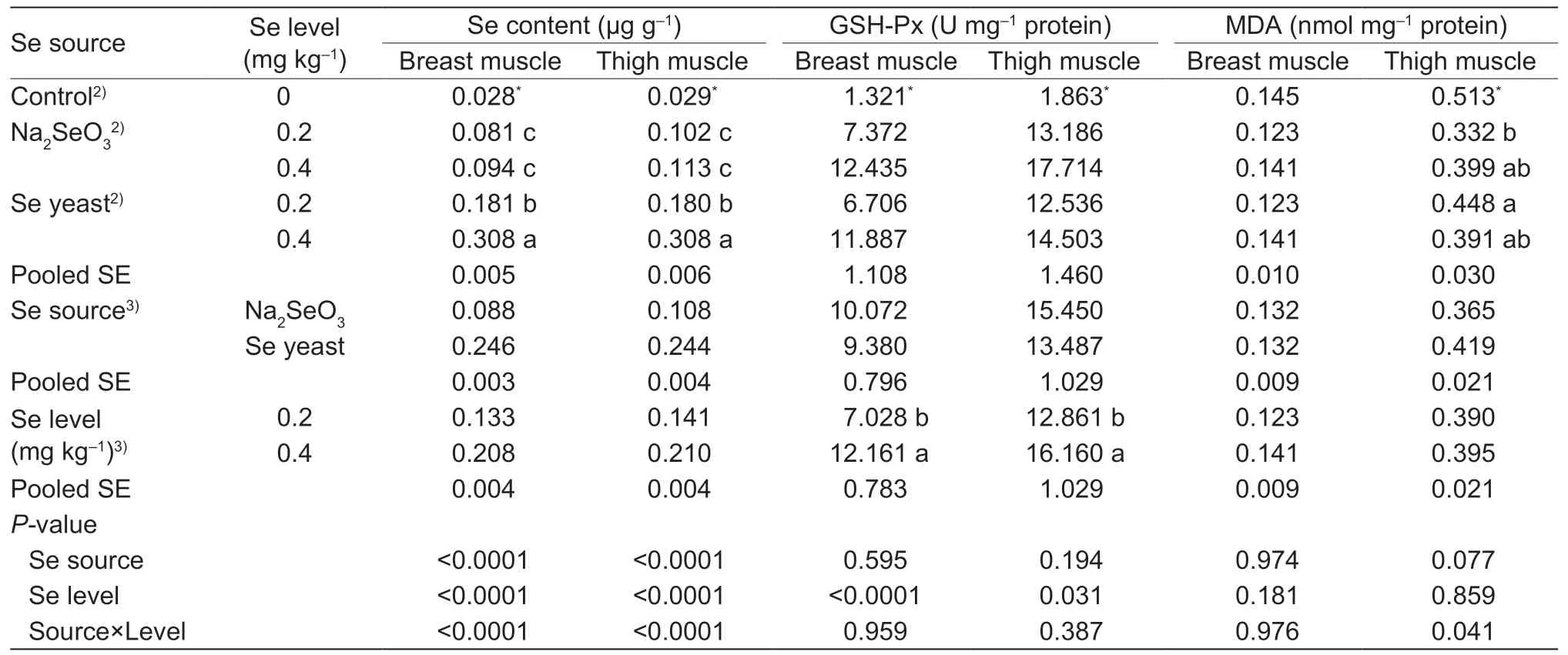
Table 6 Effects of dietary Se source and level on Se content and antioxidative ability in breast and thigh muscles of broilers1)
As expected,all Se-supplemented treatments had higher Se content in breast and thigh muscles than the control treatment,and the similar results have been reported by Krstićet al.(2012). Moreover,the chicks fed the Se yeast diets at 0.40 mg Se kg-1had the highest Se content in breast and thigh muscles than those fed any other diets.The results of the present study are in agreement with other studies,indicating that the Se from Se yeast is more effective in Se deposition in meat of chicken than the Se from sodium selenite (Payne and Southern 2005; Wang and Xu 2008; Wanget al.2011a,b). This might be related to different metabolic utilization pathways between the two Se sources. The Se from Se yeast is mainly in the form of selenomethionine (SeMet),which can be incorporated nonspecifically into proteins in place of Met (Whanger 2002;Kieliszek and Błażejak 2013,2016; Delezieet al.2014).Thus,more Se from Se yeast than from sodium selenite can be stored in the muscles of broilers.
5.Conclusion
The results from the present study indicated that supplemental Se could increase the growth performance,muscle Se concentration and antioxidative ability of broilers;and the Se from Se yeast was more effective than the Se from sodium selenite in improving meat quality of broilers.It is recommended that the appropriate supplemental level of Se as Se yeast might be 0.40 mg kg-1for improving the meat quality of broilers.
Acknowledgements
This research was financially supported by the National Natural Science Foundation of China (31601956),the Agricultural Science and Technology Innovation Program,China (ASTIP-IAS09),and the earmarked fund for the China Agriculture Research System (CARS-41),the earmarked fund for Hebei Chicken Innovation Team of Modern Agro-industry Technology Research System,China(HBCT2018150203 and HBCT2018150206).
 Journal of Integrative Agriculture2021年1期
Journal of Integrative Agriculture2021年1期
- Journal of Integrative Agriculture的其它文章
- The dynamic impact of income and income distribution on food consumption among adults in rural China
- Driving factors of direct greenhouse gas emissions from China’s pig industry from 1976 to 2016
- ATP regulates the phosphorylation and degradation of myofibrillar proteins in ground ovine muscle
- Use of two-stage dough mixing process in improving water distribution of dough and qualities of bread made from wheatpotato flour
- lmpact of climate change on maize yield in China from 1979 to 2016
- Estimating daily actual evapotranspiration of a rice-wheat rotation system in typical farmland in the Huai River Basin using a two-step model and two one-step models
